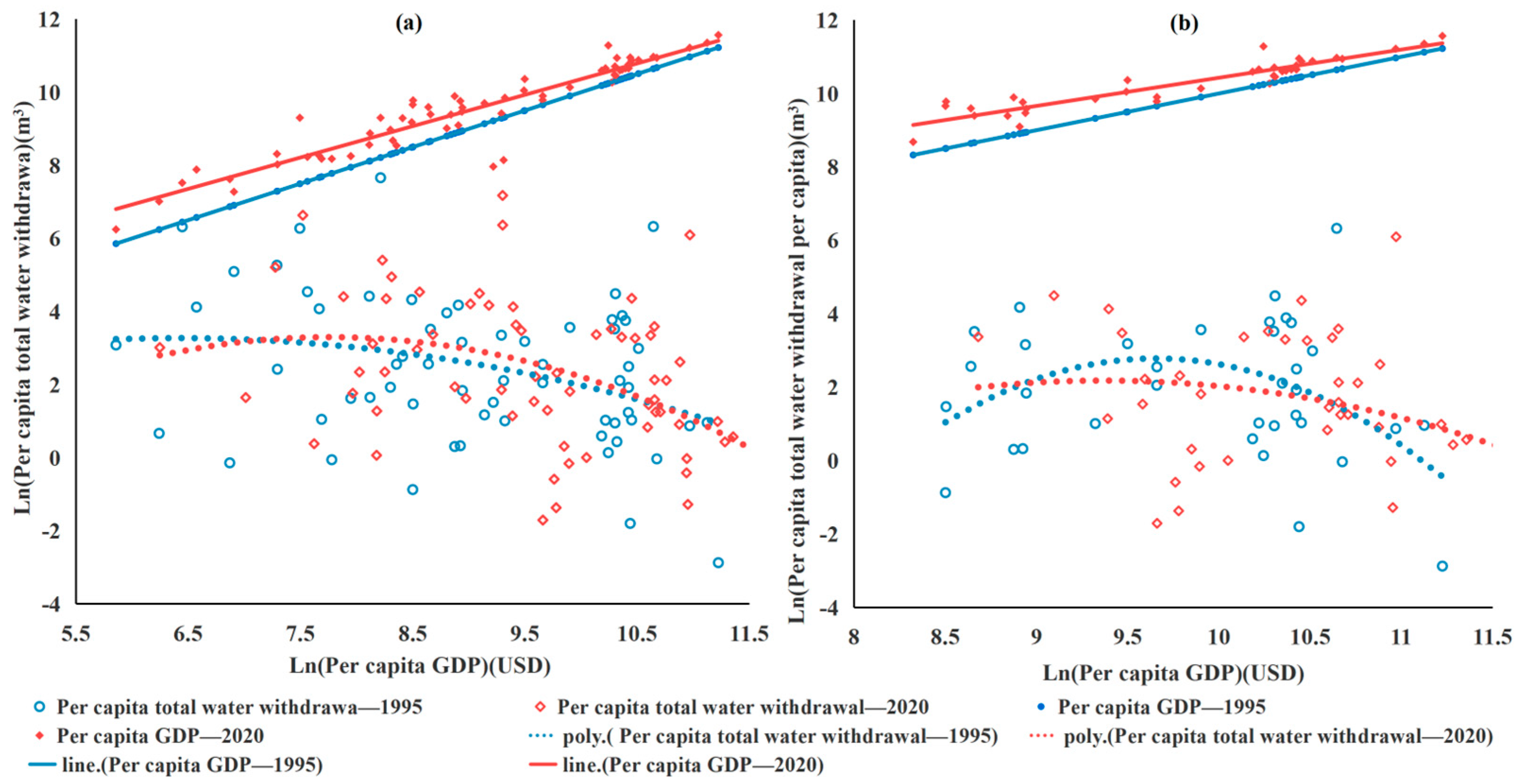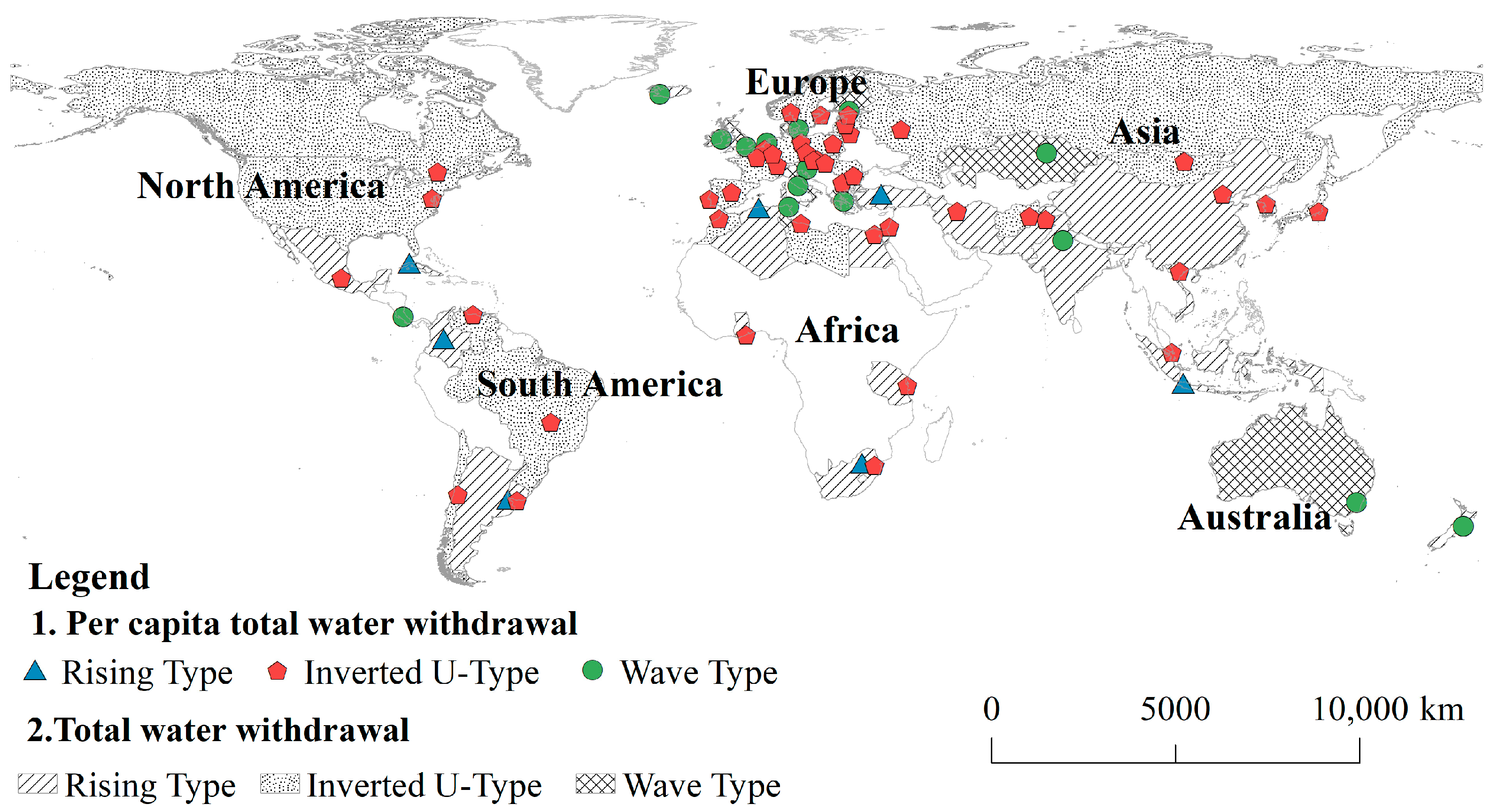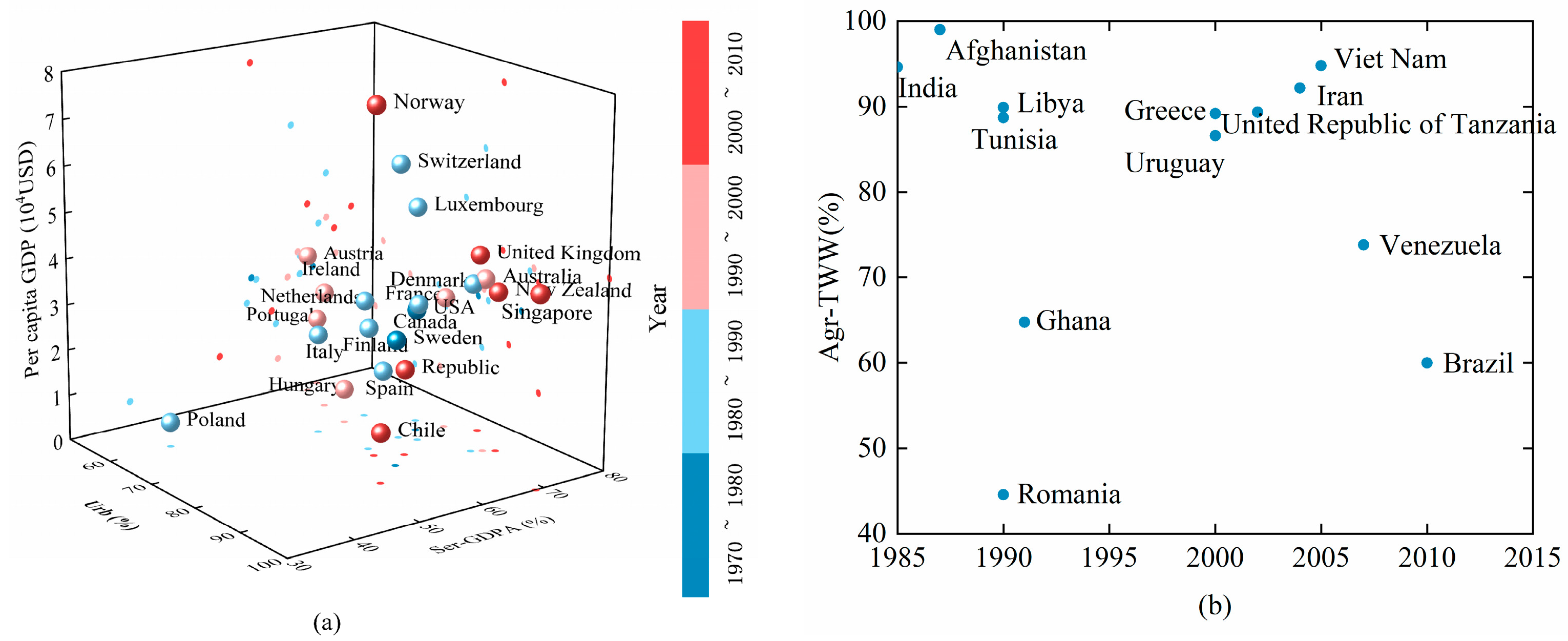Global Water Use and Its Changing Patterns: Insights from OECD Countries
Abstract
1. Introduction
2. Data and Methods
2.1. Data
2.2. Research Methods
2.2.1. Panel Smooth Transition Regression Model
2.2.2. Drivers of Water Use
3. Results
3.1. Overall Level of Global Water Use
3.2. Trends in Global Water Use
3.3. Spatial Patterns of Global Water Use
4. Discussion
4.1. Drivers of Water Use Trends
4.2. Control Factors and Critical Thresholds
5. Conclusions
- (1)
- At the global level, trends in water use can be categorized into three primary types: rising type, inverted U-type, and wave type. Notably, countries exhibiting an inverted U-type trend in per capita total water withdrawal represent approximately 70% of the global total. From a spatial distribution perspective, the inverted U-type and wave-type trends are predominantly observed in Europe, the Americas, Oceania, and North Asia. In contrast, the rising type is primarily evident in Africa, certain regions of Asia, and Latin America.
- (2)
- The per capita total water withdrawal is significantly influenced by improvements in water use efficiency, particularly evident in the plateaus and declines observed within OECD countries. Conversely, structural upgrades play a crucial role in the reduction of water consumption in non-OECD countries. Technological innovations and structural upgrades are vital for decreasing municipal and industrial water withdrawals while ensuring stability in agricultural water withdrawals. However, these strategies alone are insufficient to address the persistent challenges posed by severe constraints on water resources. Additional factors, such as the urbanization, the level of economic development, and policy guidance, also significantly impacts trends in water consumption.
- (3)
- When water usage in OECD countries reaches its peak, the Ser-GDPA generally exceeds 60%, the urbanization rate surpasses 70%, and the per capita GDP exceeds USD 20,000. Analyzing the development trend of agricultural water withdrawals will be crucial for non-OECD countries to accurately project future water demand.
Author Contributions
Funding
Data Availability Statement
Conflicts of Interest
References
- Zubaidi, S.L.; Al-Bugharbee, H.; Ortega-Martorell, S.; Gharghan, S.K.; Olier, I.; Hashim, K.S.; Al-Bdairi, N.S.; Kot, P. A novel methodology for prediction urban water demand by wavelet denoising and adaptive neuro-fuzzy inference system approach. Water 2020, 12, 1628. [Google Scholar] [CrossRef]
- Wada, Y.; van Beek, L.P.; Bierkens, M.F. Modelling global water stress of the recent past: On the relative importance of trends in water demand and climate variability. Hydrol. Earth Syst. Sci. 2011, 15, 3785–3808. [Google Scholar] [CrossRef]
- Soligno, I.; Malik, A.; Lenzen, M. Socioeconomic drivers of global blue water use. Water Resour. Res. 2019, 55, 5650–5664. [Google Scholar] [CrossRef]
- WWAP (United Nations World Water Assessment Programme). The United Nations World Water Development Report 2018: Nature-Based Solutions. Paris. UNESCO. Available online: www.unwater.org/publications/world-water-development-report-2018/ (accessed on 8 October 2024).
- Munia, H.A.; Guillaume, J.H.; Wada, Y.; Veldkamp, T.; Virkki, V.; Kummu, M. Future transboundary water stress and its drivers under climate change: A global study. Earth’s Future 2020, 8, e2019EF001321. [Google Scholar] [CrossRef] [PubMed]
- Su, Y.; Li, X.; Feng, M.; Nian, Y.; Huang, L.; Xie, T.; Zhang, K.; Chen, F.; Huang, W.; Chen, J.; et al. High agricultural water consumption led to the continued shrinkage of the Aral Sea during 1992–2015. Sci. Total Environ. 2021, 777, 145993. [Google Scholar] [CrossRef]
- AI-Mashagbah, A.F.; Ibrahim, M.; Al-Fugara, A. Estimation of changes in the Dead Sea surface water area through multiple water index algorithms and geospatial techniques. Glob. Nest J. 2021, 23, 565–571. [Google Scholar] [CrossRef]
- Hung, F.; Son, K.; Yang, Y.E. Investigating uncertainties in human adaptation and their impacts on water scarcity in the Colorado river Basin, United States. J. Hydrol. 2022, 612, 128015. [Google Scholar] [CrossRef]
- Chen, Y.P.; Fu, B.J.; Zhao, Y.; Wang, K.B.; Zhao, M.M.; Ma, J.F.; Wu, J.H.; Xu, C.; Liu, W.G.; Wang, H. Sustainable development in the Yellow River Basin: Issues and strategies. J. Clean. Prod. 2020, 263, 121223. [Google Scholar] [CrossRef]
- Cruse, R.M.; Devlin, D.L.; Parker, D.; Waskom, R.M. Irrigation aquifer depletion: The nexus linchpin. J. Environ. Stud. Sci. 2016, 6, 149–160. [Google Scholar] [CrossRef]
- Mehta, L. Water and Human Development. World Dev. 2014, 59, 59–69. [Google Scholar] [CrossRef]
- Leijnse, M.; Bierkens, M.F.; Gommans, K.H.; Lin, D.; Tait, A.; Wanders, N. Key drivers and pressures of global water scarcity hotspots. Environ. Res. Lett. 2024, 19, 054035. [Google Scholar] [CrossRef]
- Graham, N.T.; Hejazi, M.I.; Chen, M.; Davies, E.G.; Edmonds, J.A.; Kim, S.H.; Turner, S.W.; Li, X.; Vernon, C.R.; Calvin, K.; et al. Humans drive future water scarcity changes across all Shared Socioeconomic Pathways. Environ. Res. Lett. 2020, 15, 014007. [Google Scholar] [CrossRef]
- Shiklomanov, I.A. Appraisal and assessment of world water resources. Water Int. 2000, 25, 11–32. [Google Scholar] [CrossRef]
- Cosgrove, W.J.; Rijsberman, F.R. Water Futures. In World Water Vision: Making Water Everybody’s Business; Cosgrove, W.J., Rijsberman, F.R., Eds.; Routledge: London, UK, 2000; pp. 23–48. [Google Scholar] [CrossRef]
- Herrington, P. Water Demand Forecasting in OECD Countries; Environment Directorate, Organisation for Economic Co-Operation and Development: Paris, France, 1987. [Google Scholar]
- Zhao, Y.; Li, H.; Liu, H.; Wang, L.; He, G.; Wang, H. The law of growth: Prediction of peak water consumption in China. J. Hydraul. Eng. 2021, 52, 129–141. [Google Scholar] [CrossRef]
- Daniell, K.A.; Rinaudo, J.D.; Chan, N.W.W.; Nauges, C.; Grafton, Q. Long-Term Water Demand Forecasting. In Understanding and Managing Urban Water in Transition; Rinaudo, J.D., Ed.; Global Issues in Water Policy; Springer: Dordrecht, The Netherlands, 2015; Volume 15, pp. 239–419. [Google Scholar] [CrossRef]
- Donkor, E.A.; Mazzuchi, T.A.; Soyer, R.; Alan Roberson, J. Urban water demand forecasting: Review of methods and models. J. Water Resour. Plan. Manag. 2014, 140, 146–159. [Google Scholar] [CrossRef]
- Guo, L.; Zhu, W.; Wei, J.; Wang, L. Water demand forecasting and countermeasures across the Yellow River basin: Analysis from the perspective of water resources carrying capacity. J. Hydrol. Reg. Stud. 2022, 42, 101148. [Google Scholar] [CrossRef]
- González, A.; Teräsvirta, T.; van Dijk, D. Panel Smooth Transition Regression Models; Quantitative Finance Research Centre, University of Technology: Sydney, Australia, 2005. [Google Scholar]
- Hansen, B.E. Sample splitting and threshold estimation. Econometrica 2000, 68, 575–603. [Google Scholar] [CrossRef]
- Steffen, W.; Broadgate, W.; Deutsch, L.; Gaffney, O.; Ludwig, C. The trajectory of the Anthropocene: The great acceleration. Anthr. Rev. 2015, 2, 81–98. [Google Scholar] [CrossRef]
- Wada, Y.; Wisser, D.; Eisner, S.; Flörke, M.; Gerten, D.; Haddeland, I.; Hanasaki, N.; Masaki, Y.; Portmann, F.T.; Stacke, T.; et al. Multimodel projections and uncertainties of irrigation water demand under climate change. Geophys. Res. Lett. 2013, 40, 4626–4632. [Google Scholar] [CrossRef]
- Wada, Y.; Wisser, D.; Bierkens, M.F. Global modeling of withdrawal, allocation and consumptive use of surface water and groundwater resources. Earth Syst. Dyn. 2014, 5, 15–40. [Google Scholar] [CrossRef]
- Wada, Y.; Bierkens, M.F. Sustainability of global water use: Past reconstruction and future projections. Environ. Res. Lett. 2014, 9, 104003. [Google Scholar] [CrossRef]
- Gupta, R.; Yan, K.; Singh, T.; Mo, D. Domestic and international drivers of the demand for water resources in the context of water scarcity: A cross-country study. J. Risk Financ. Manag. 2020, 13, 255. [Google Scholar] [CrossRef]
- Sun, S.; Zheng, X.; Liu, X.; Wang, Z.; Liang, L. Global pattern and drivers of water scarcity research: A combined bibliometric and geographic detector study. Environ. Monit. Assess. 2022, 194, 523. [Google Scholar] [CrossRef] [PubMed]
- Zhou, F.; Bo, Y.; Ciais, P.; Dumas, P.; Tang, Q.; Wang, X.; Liu, J.; Zheng, C.; Polcher, J.; Yin, Z.; et al. Deceleration of China’s human water use and its key drivers. Proc. Natl. Acad. Sci. USA 2020, 117, 7702–7711. [Google Scholar] [CrossRef] [PubMed]
- Water, U.N. Progress on Level of Water Stress: Global Baseline for SDG Indicator 6.4. 2. UN Water, 24 August 2018. Available online: https://www.unwater.org/publications/progress-on-level-of-water-stress-642/ (accessed on 10 August 2024).
- Gleick, P.H.; Cooley, H. Freshwater scarcity. Annu. Rev. Environ. Resour. 2021, 46, 319–348. [Google Scholar] [CrossRef]
- Katz, D. Water use and economic growth: Reconsidering the Environmental Kuznets Curve relationship. J. Clean. Prod. 2015, 88, 205–213. [Google Scholar] [CrossRef]
- Song, Z.; Jia, S. Municipal water use Kuznets curve. Water Resour. Manag. 2023, 37, 235–249. [Google Scholar] [CrossRef]
- Cole, M.A. Economic growth and water use. Appl. Econ. Lett. 2004, 11, 1–4. [Google Scholar] [CrossRef]
- Chen, R.C.; Dewi, C.; Huang, S.W.; Caraka, R.E. Selecting critical features for data classification based on machine learning methods. J. Big Data 2020, 7, 52. [Google Scholar] [CrossRef]
- Gaines, M.D.; Tulbure, M.G.; Perin, V. Effects of climate and anthropogenic drivers on surface water area in the southeastern United States. Water Resour. Res. 2022, 58, e2021WR031484. [Google Scholar] [CrossRef]
- Song, S.; He, R.; Shi, Z.; Zhang, W. Variable importance measure system based on advanced random forest. Comput. Model. Eng. Sci. 2021, 128, 65–85. [Google Scholar] [CrossRef]
- Amarasinghe, U.A.; Smakhtin, V. Global Water Demand Projections: Past, Present and Future; International Water Management Institute (IWMI): Colombo, Sri Lanka, 2014; Volume 156, p. 32. [Google Scholar] [CrossRef]
- Alcamo, J.; Flörke, M.; Märker, M. Future long-term changes in global water resources driven by socio-economic and climatic changes. Hydrol. Sci. J. 2007, 52, 247–275. [Google Scholar] [CrossRef]
- Kramer, I.; Tsairi, Y.; Roth, M.B.; Tal, A.; Mau, Y. Effects of population growth on Israel’s demand for desalinated water. Npj Clean Water 2022, 5, 67. [Google Scholar] [CrossRef]
- Shen, Y.; Oki, T.; Kanae, S.; Hanasaki, N.; Utsumi, N.; Kiguchi, M. Projection of future world water resources under SRES scenarios: An integrated assessment. Hydrol. Sci. J. 2014, 59, 1775–1793. [Google Scholar] [CrossRef]
- Veldkamp, T.I.; Wada, Y.; de Moel, H.; Kummu, M.; Eisner, S.; Aerts, J.C.; Ward, P.J. Changing mechanism of global water scarcity events: Impacts of socioeconomic changes and inter-annual hydro-climatic variability. Glob. Environ. Chang. 2015, 32, 18–29. [Google Scholar] [CrossRef]
- Fant, C.; Schlosser, C.A.; Gao, X.; Strzepek, K.; Reilly, J. Projections of water stress based on an ensemble of socioeconomic growth and climate change scenarios: A case study in Asia. PLoS ONE 2016, 11, e0150633. [Google Scholar] [CrossRef] [PubMed]
- Wada, Y.; Flörke, M.; Hanasaki, N.; Eisner, S.; Fischer, G.; Tramberend, S.; Satoh, Y.; Van Vliet, M.T.H.; Yillia, P.; Ringler, C.J.G.M.D.; et al. Modeling global water use for the 21st century: The Water Futures and Solutions (WFaS) initiative and its approaches. Geosci. Model Dev. 2016, 9, 175–222. [Google Scholar] [CrossRef]
- Distefano, T.; Kelly, S. Are we in deep water? Water scarcity and its limits to economic growth. Ecol. Econ. 2017, 142, 130–147. [Google Scholar] [CrossRef]
- Donnelly, K.; Cooley, H. Water Use Trends in the United States; Pacific Institute: Oakland, CA, USA, 2015; Available online: https://pacinst.org/publication/water-use-trends-in-the-united-states (accessed on 8 September 2024).
- Konar, M.; Marston, L. The water footprint of the United States. Water 2020, 12, 3286. [Google Scholar] [CrossRef]






| Variables | Units | Variables | Units |
|---|---|---|---|
| Agricultural water withdrawal | m3 | Industry, value added to GDP | USD |
| Agriculture, value added to GDP | USD | Municipal water withdrawal | m3 |
| Cultivated area (arable land + permanent crops) | ha | Services, value added to GDP | USD |
| GDP deflator (2015) | Total renewable water resources per capita | m3/inhab | |
| GDP | USD | Total population | inhab |
| Industrial water withdrawal | m3 | Urban population | inhab |
| Indicator Category | Acronym | Description | Unit |
|---|---|---|---|
| Development scale | CA | Cultivated area (arable land + permanent crops) | ha |
| GDP | Gross domestic product | USD | |
| Urb | Urbanization | % | |
| Water Resources condition | Trwrpc | Total renewable water resources per capita | m3/inhab |
| Production structure | Agr-GDPA | Agriculture, value added (% GDP) | % |
| Ind-GDPA | Industrial, value added (% GDP) | % | |
| Ser-GDPA | Services, value added (% GDP) | % | |
| Water use structure | Agr-TWW | Agricultural water withdrawals as % of total water withdrawals | % |
| Ind-TWW | Industrial water withdrawals as % of total water withdrawals | % | |
| Mun-TWW | Municipal water withdrawals as % of total water withdrawals | % | |
| Production level | AgrUSE | Agricultural water use efficiency | USD/m3 |
| IndUSE | Industrial water use efficiency | USD/m3 | |
| SerUSE | Services water use efficiency | USD/m3 | |
| Climate change | Pre | Precipitation | mm |
| Tem | Temperature | °C |
| m = 1 | m = 2 | |||||
|---|---|---|---|---|---|---|
| LM | LMF | LRT | LM | LMF | LRT | |
| Linear tests (H0: r = 0; H1: r = 1) | 20.913 (0.000) | 20.540 (0.000) | 20.999 (0.000) | 20.957 (0.000) | 10.288 (0.000) | 21.043 (0.000) |
| 2 transition functions (H0: r = 2; H1: r = 3) | 2.728 (0.099) | 2.657 (0.103) | 2.729 (0.099) | 8.250 (0.016) | 4.025 (0.018) | 8.264 (0.016) |
| AIC | 11.766 | 11.769 | ||||
| BIC | 11.779 | 11.786 | ||||
Disclaimer/Publisher’s Note: The statements, opinions and data contained in all publications are solely those of the individual author(s) and contributor(s) and not of MDPI and/or the editor(s). MDPI and/or the editor(s) disclaim responsibility for any injury to people or property resulting from any ideas, methods, instructions or products referred to in the content. |
© 2024 by the authors. Licensee MDPI, Basel, Switzerland. This article is an open access article distributed under the terms and conditions of the Creative Commons Attribution (CC BY) license (https://creativecommons.org/licenses/by/4.0/).
Share and Cite
Zhu, X.; Hou, M.; Wei, J. Global Water Use and Its Changing Patterns: Insights from OECD Countries. Water 2024, 16, 3592. https://doi.org/10.3390/w16243592
Zhu X, Hou M, Wei J. Global Water Use and Its Changing Patterns: Insights from OECD Countries. Water. 2024; 16(24):3592. https://doi.org/10.3390/w16243592
Chicago/Turabian StyleZhu, Xiaomei, Minglei Hou, and Jiahua Wei. 2024. "Global Water Use and Its Changing Patterns: Insights from OECD Countries" Water 16, no. 24: 3592. https://doi.org/10.3390/w16243592
APA StyleZhu, X., Hou, M., & Wei, J. (2024). Global Water Use and Its Changing Patterns: Insights from OECD Countries. Water, 16(24), 3592. https://doi.org/10.3390/w16243592







